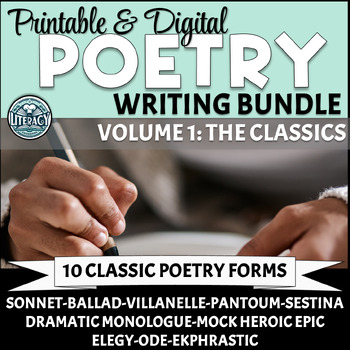Poetry Writing Bundle - 10 Classic Poetic Forms - Volume 1 - Digital & Printable
- Zip
- Google Apps™
- Easel Activity

Products in this Bundle (10)
showing 1-5 of 10 products
Bonus
Description
Writing classic poems is perfect for ANY poetry unit, or poetry-writing can be integrated into various units throughout the year. You won't want to wait until April for National Poetry Month! These ten poetic forms provide students experience with writing the 10 most popular classic poetry structures. Your students will be writing like the Masters by the end of the year!
Included in this bundle:
- Sonnet
- Ballad
- Ode
- Elegy
- Ekphrastic Poetry (response to art)
- Villanelle
- Dramatic Monologue
- Mock Heroic Epic
- Pantoum
- Sestina
⭐ Bonus Product included with Bundle: Digital Poetry Journal (only available in this bundle)
What’s Included? Each lesson contains ...
⭐ Assignment Sheet with Detailed Process Description: Guides students through each step of crafting their poem, from initial brainstorming to the final verse.
⭐ Writing Form for Poem Structure: Helps students easily follow the format of the poetry form, ensuring they know how to proceed.
⭐ Product-Specific Rubric for Easy Assessment: Simplifies the evaluation process with clear criteria, making it straightforward to assess each student-written poem.
⭐ Mentor Texts and Examples: Offers students ideas and styles to draw from, kickstarting their creativity and confidence in writing.
Sequence for Instruction in British Literature Course:
- Anglo-Saxon: Elegy (Elegy to Beowulf)
- Medieval: Ballad
- The Renaissance: Sonnet
- Restoration: Mock Heroic Epic
- Romantic: Ode & Ekphrastic Poetry
- Victorian: Dramatic Monologue
- Modern/Post-Modern: Sestina, Pantoum, & Villanelle
Designed for Low-No Preparation:
This is a rigorous poetry-writing activity for students and can easily be integrated into a novel study or poetry unit. Crafted to save you prep-time while maximizing student engagement and learning outcomes, it’s an excellent choice to include with emergency substitute lesson plans.
Check out other poetry resources in the store.
Thank you for visiting my store!
Melinda
melindajhall@literacycookbook.net
Copyright © The Literacy Cookbook
All rights reserved by the author.
Permission to copy for single classroom use only.





